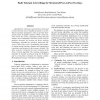39 search results - page 3 / 8 » Discovering Network Topology in the Presence of Byzantine Fa... |
WDAG
2007
Springer
15 years 5 months ago
2007
Springer
Consider a distributed network of n nodes that is connected to a global source of “beats”. All nodes receive the “beats” simultaneously, and operate in lock-step. A scheme ...
115
click to vote
COMSUR
2011
13 years 11 months ago
2011
Interference is an unavoidable property of the wireless communication medium and, in sensor networks, such interference is exacerbated due to the energy-starved nature of the netw...
LCN
2005
IEEE
15 years 5 months ago
2005
IEEE
Algorithms by which peers join and leave structured overlay networks can be classified as passive or active. Passive topology maintenance relies on periodic background repair of n...
140
click to vote
PODC
2012
ACM
13 years 2 months ago
2012
ACM
The goal of Byzantine Broadcast (BB) is to allow a set of fault-free nodes to agree on information that a source node wants to broadcast to them, in the presence of Byzantine faul...
104
click to vote
PODC
2012
ACM
13 years 2 months ago
2012
ACM
This paper proves a necessary and sufficient condition for the existence of iterative algorithms that achieve approximate Byzantine consensus in arbitrary directed graphs, where e...



